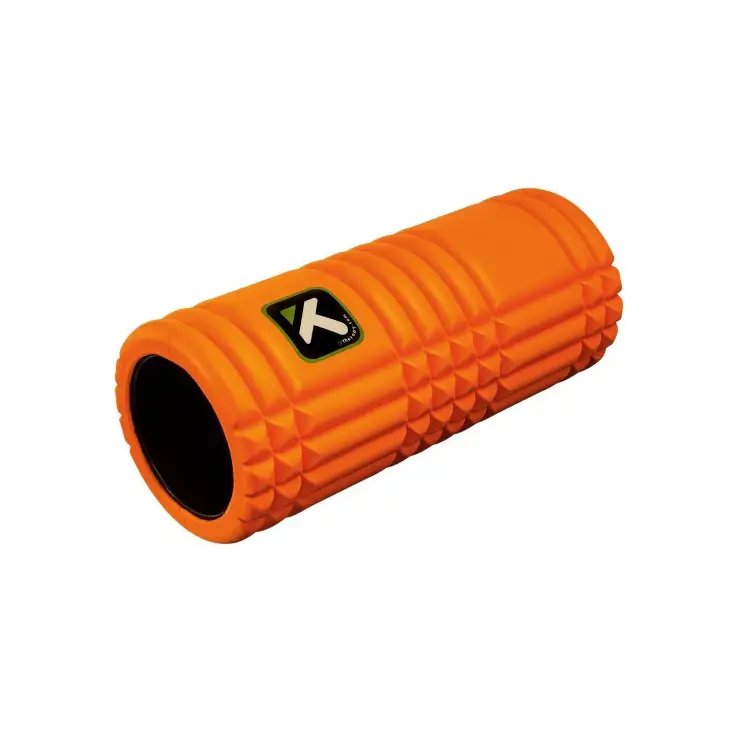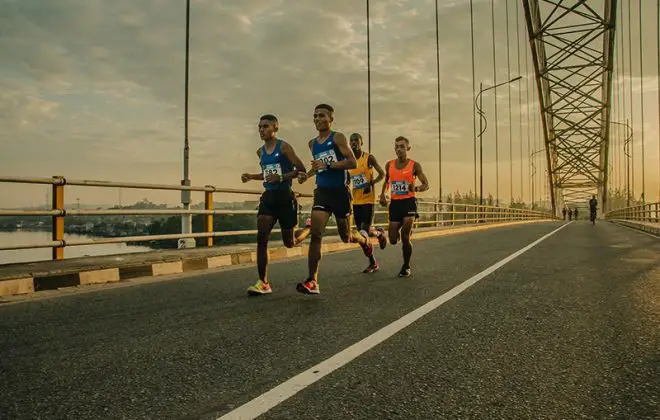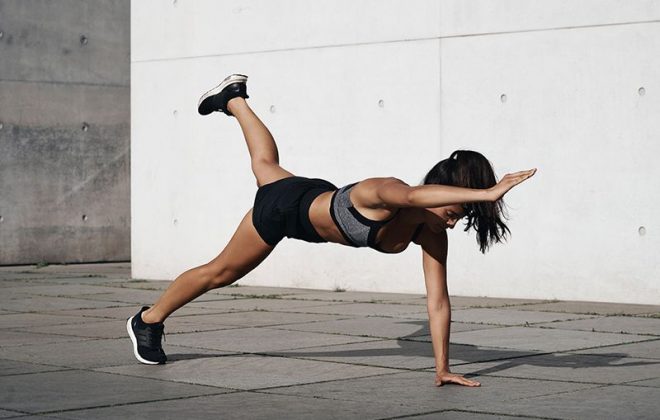Minimalist Ironman Training Program & Tips For Busy Triathletes
Ironman triathlon is an ultra endurance race. Training for it is notoriously difficult and can easily consume all free time. So, instead of doing more volume, I created a minimalist Ironman training program that helped me get as efficient as possible.
The program helped me focus on high quality shorter training sessions. Also, I managed to maintain normal life outside of swimming, biking and running.
In this post I’ll share the principles I followed and how I set my minimalist Ironman training program up.
Ironman triathlon
With a 3.8K swim, 180K bike ride and a full 42.2K marathon (all in one go) Ironman triathlon is considered the single toughest one-day sporting event in the world.
Completing it is a process of discovering what you’re really made of, but is excruciatingly difficult. The race starts shortly before 7AM and whoever crosses the finish line before midnight is called an Ironman. So, it’s basically a very long (up to 17hrs) and tedious conversation with yourself.
Ironman Triathon
Professional athletes train upwards of 30 hours every week to complete the distance in just under 8 hours. A typical Ironman training program would suggest ~20 hours of swimming, biking and running per week. That’s roughly 2 – 3 hours of training every day.
My minimalist Ironman training program principles
For my first Ironman I needed a program that is efficient. Like many other triathletes, I have a day job and can’t allow myself the luxury of spending 3 hours every day swimming, biking and running. Even though I’d enjoy it. So, I designed my minimalist Ironman training program with specific goals in mind:
- keep most of the sessions short to recover quickly
- focus as much as possible on the quality of every session
- save time wherever possible and make training a lifestyle

I finished my first Ironman in 10h 48m. However, despite all the setbacks I had (mistakes in peak weeks & fueling during the race), I believe the principles and the program below are good for a sub-10 hour Ironman finish.
In fact, I don’t think I’d change much for my next race – definitely not on the volume side. As I see it, with optimized training ~10 hours/week is more than enough not only to finish, but also to do a sub 10-hour Ironman.
Principle #1 – stay consistent, minimize fatigue and supercompensate often
My main principle for the training process was to stay as consistent as possible and do a form of exercise every day. Even if that meant backing off or cutting some sessions short.
As I see it, having several moderate or even ‘ok’ sessions close to each other is much more efficient than one hard session that requires several days to recover from. This way an athlete is not ‘digging a hole’ for himself, but is making gradual progress every week or so.
Standard weekly schedule
What helped me bring structure to my training was creating a standard weekly schedule. Sort of a ‘perfect week’ example of what sessions I should do every week.
While I did move the timing of many training sessions based on how my recovery was progressing (i.e. swapping cycling for swimming), a typical week in my head looked like this:
| Swim | Bike | Run | |
| Monday | Easy spin (<100w) | ||
| Tuesday | pool swim | Bike intervals | |
| Wednesday | Bike aerobic | Run off the bike | |
| Thursday | pool swim | Run intervals | |
| Friday | Bike intervals | Easy run | |
| Saturday | Long ride | Short run off the bike | |
| Sunday | Easy ride | Long run off the bike |
On some weeks I managed to stick to this schedule 100%, while on others I had to make changes (especially when I traveled).
Most importantly, having a split of what time I should devote to each sport and what sessions I should do was very helpful at automating the whole process.
More frequent and shorter sessions
While the schedule above looks intense, none of the sessions on workdays were long. Instead, I focused on shorter (or easier) but frequent sessions to trigger small and consistent adaptations. It’s a much more efficient way of building endurance. Especially for a race like Ironman which is almost exclusively a Zone 2 effort.
Having had bad experience with too much volume & intensity previously, marathon and Ironman training helped me understand one very important thing:
Training doesn’t have to keep you broken. It’s only needed to trigger the adaptation process.
In practice, mitochondria, that power aerobic efforts, grow within 24 hours after the exercise, so frequent easier sessions stimulate the body to supercompensate quicker. At the same time they are very sensitive to fatigue – one interval too much or too intense can overload mitochondria and limit progress.
For this reason I kept intense sessions & intervals short, which helped me keep overall fatigue low. Often I’d split a larger session into two smaller ones throughout the day if I felt under-recovered.
Also, as I started running in spring, I focused on short 30-minute sessions to gradually build strength in hips and calves that eventually helped me maintain form during longer efforts.
Related: How Supercompensation & Consistency Make Athletes Uber Fit
Stay active on rest days
Rest days were always a trouble for me. I always tend to feel stiff after a day of no training. Probably, because I spend it on the couch or working at the desk.
What I found during Ironman training is that the best recovery for me is an easy mobility session or a 30 minute spin on the bike (no higher than 100watts or 100bpm). Easy movement does better job at clearing accumulated fatigue and lactic acid than passive rest.
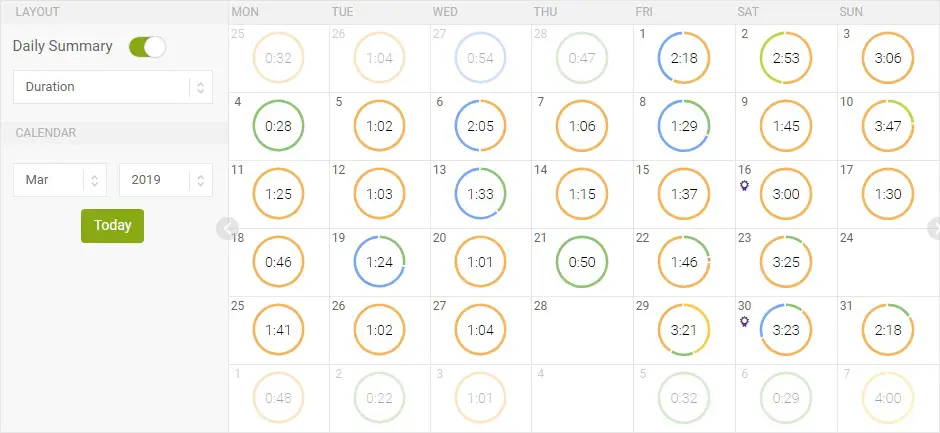
Principle #2 – focus on quality of every session in the Ironman training program
Being good at Ironman distance requires two things. First is building an efficient aerobic engine to save as much energy as possible. And second is having a durable body that is able to stay strong for long periods of time. Training both requires a mix of low and high intensity sessions, which can be tricky to achieve in 10 hours per week across 3 different sports.
In my minimalist Ironman training I chose to focus on the bike (~70% of total volume). It’s the longest discipline and the one I have the least experience in. What I also learned is that bike is the best and safest way to build aerobic endurance and strength. You can execute very structured low & high intensity sessions and add a lot of volume without much risk of injury.
I believe focusing most of my effort on the bike was the critical factor in staying consistent and injury-free throughout my Ironman training program.
Long & easy bike rides and runs
The most important session of my Ironman training plan was the long bike on Saturdays (and later in the program also long run on Sundays). These long rides (and runs) are best at preparing the body for physiological demands of the race. It’s important to note that intensity for me was not as important as just going the distance.
The real effect of this kind of training happens only in the final 30-60 minutes when the body is already tired.
What happens physiologically is oxidative muscle fibers (slow twitch) start to fatigue and glycolictic (fast twitch) muscle fibers start to take over the work. Activating these fast twitch muscle fibers stimulates the growth of mitochondria in them. It ultimately transforms them to more oxidative and, therefore, efficient fibers.
When I was traveling I tried to get creative and include the long bike ride during the week. It was either a long ride of ~3 hours right after work or two sessions ~2 hours each in a single day (morning & afternoon).
Interval training
So, our body becomes more efficient (endure) when we make our fast twitch muscle fibers operate with oxygen. By building mitochondria in them. Luckily, long and easy training is not the only way to get fast twitch muscle fibers to grow mitochondria. Otherwise, I’d have to do a 2-3 hour ride every day to maintain the effect.
Medium & high intensity intervals performed not until exhaustion also stimulate growth of mitochondria in fast twitch muscle fibers, making them more efficient.
Besides long weekends, all of my training throughout the week was done in intervals. Majority of them were longer efforts in Zone 3 with very short rests in between. Thanks to these ‘sub-threshold’ intervals I was able to add quite a lot of base strength and recover quickly to add many sessions.
Even easy/recovery sessions rotated Zones 1 & 2 or incorporated short (up to 20 second) accelerations to 80-90%.
Related: Train Smart – Practical Guide to 5 Exercise Heart Rate Zones
Frequent short transition runs
Throughout my Ironman training program most of my running was done off the bike as quick transition runs (2-3 minute change). Generally these were ~20 minutes long, which helped me get accustomed to running on ‘tired legs’.
Running right after 4-5 hour rides in particular gave me the biggest training effect and confidence boost for the race. It also made me understand what kind of pace I’m able to maintain.
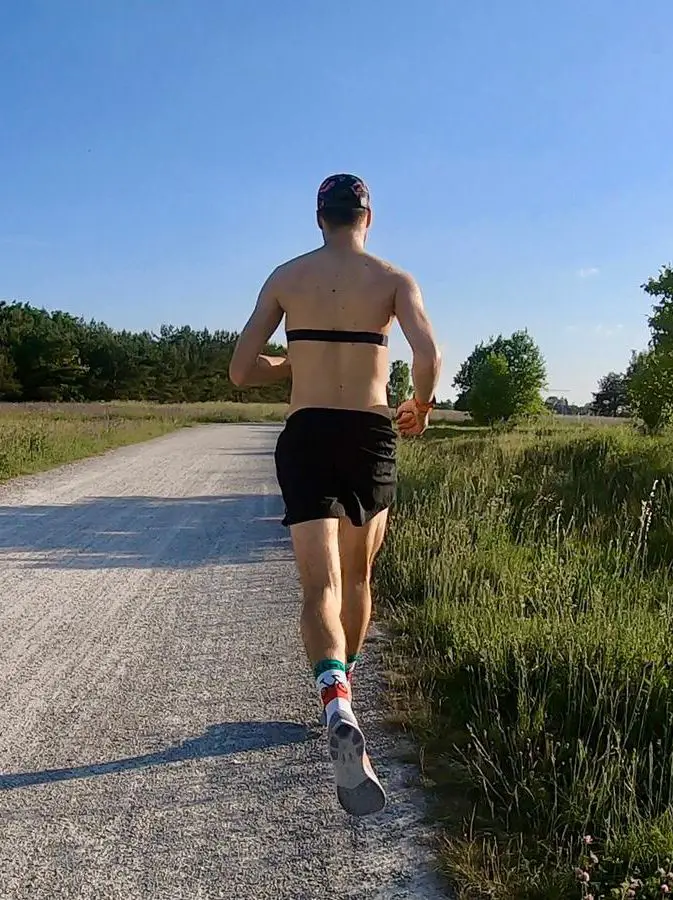
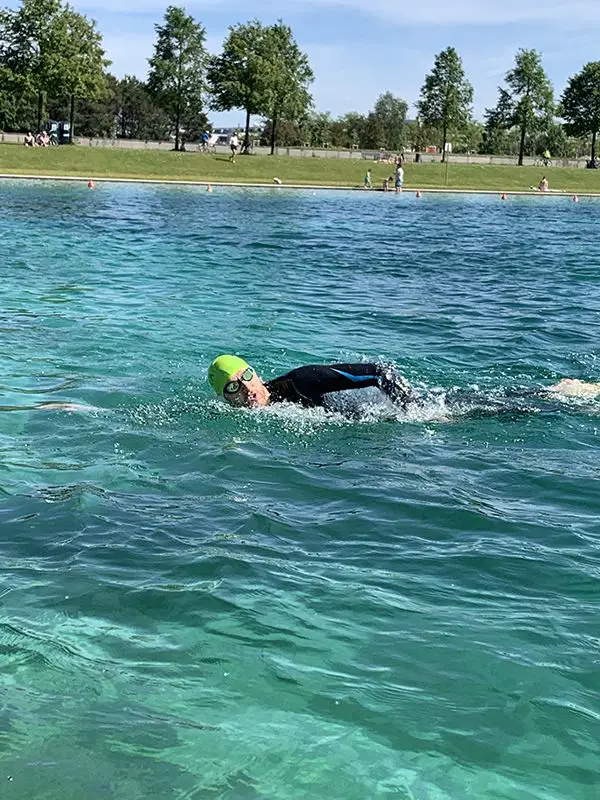
‘Do-it-all’ swimming
Swimming was the least of my worries, as I consider myself not a bad swimmer. I estimated that with 2 consistent one-hou long sessions per week I would be able to complete the swim in 1:00 – 1:10 hour range (depending on wetsuit-legal decision).
To go faster I would need to do 3-4 swims every week and probably would improve by ‘only’ 5 minutes. As swimming involves more logistics (driving to the pool, dressing, warming up, etc.) these additional 2 hours are actually more like 4. I would get much more value from biking more…
So, my two sessions were super focused and included technique work, endurance and speed. A typical session looked like this:
- Warm up. 5 minutes of work with resistance bands (focusing on the catch & pull). ~10 minutes of freestyle swimming.
- Prep drills. I used YouTube videos to find flaws in my stroke and focus on correct form with specific drills (~4 different ones for 5 minutes).
- Main set. Around ~30 minutes of either intervals with short rest (25-400m) or continuous swim (1,900m). All slightly harder than my expected Ironman pace.
- Cool down drills. Same idea as above – focus on correct form when the body is tired.
- Cool down. ~5-10 minutes of swimming trying to focus on correct technique.
Read also: 18 Practical Time Management Hacks For Athletes And Busy People
Strength, core & mobility sessions
Strong core and lower body is, probably, the most important factor for a good Ironman marathon. Hours of riding and running put a lot of stress on the body and cause the running form to deteriorate, which ultimately leads to an inefficient stride and energy wasted. Mobility, on the other hand, really helps to open up tight joints (like hips), which promotes recovery.
Strength training for endurance athletes should be explosive (intense, but short). This kind of strength training stimulates the growth of mitochondria in fast twitch muscle fibers, making them more efficient – just like interval training and long slow sessions.
During my minimalist Ironman training I tried to do a short 5-10min core work every other day and when I had extra time I added an explosive strength session (on average once every 2 weeks). Nothing fancy – deadlift & squat with ~80% of maximum for 1-2 reps. Not until fatigue.
Principle #3 – Make training a lifestyle with efficient time management
Training for the Ironman is not that hard from effort perspective. Personally, I probably spent ~95% of time in zones 1, 2 & 3. It’s the challenge of staying consistent with long weeks across 3 sports that makes it difficult.
As I have a full-time job (like most amateur triathletes), my long training days were Saturdays and Sundays, as well as public holidays and days off work. These are times when I have the most time to dedicate to training and often accounted for ~50% of total volume.
The rest of the time is where I had to be a bit creative. Even though one hour every day is definitely easier to get in than 2-3 hours, it’s still a full hour. Below are a couple of time management tips that helped me stay consistent and integrate training as a lifestyle.
Early morning training
Training early in the morning was by far the single most important time management change I did that helped me stay consistent. Most of the days my training session would start at 7AM (or 6AM if it was fasted) and I’d be done by 8. Since my training weren’t too taxing often I was able to add a second session in the afternoon.
I kept telling myself I wasn’t a morning person until I gave early morning training a try. That single experience totally changed my perspective.
Related: 5AM Morning Routine – Best Habits For A More Productive Morning
Having half or even all training done while others are asleep eliminates the possibility of something coming up later in the day and screwing up the training plan. Once it’s done in the morning your head is free.
On top of that early morning is great to do fasted training that teaches the body to utilize fat better (huge bonus during the race) and shed some excess weight as well.
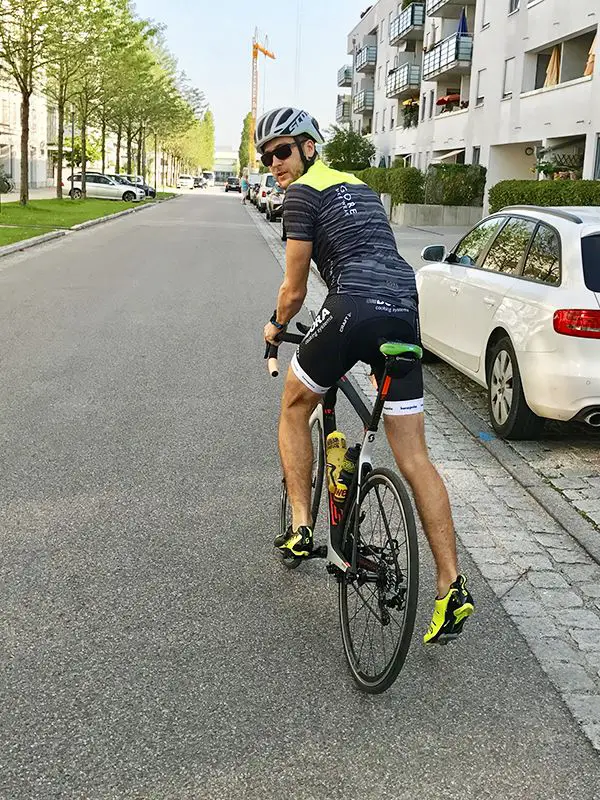
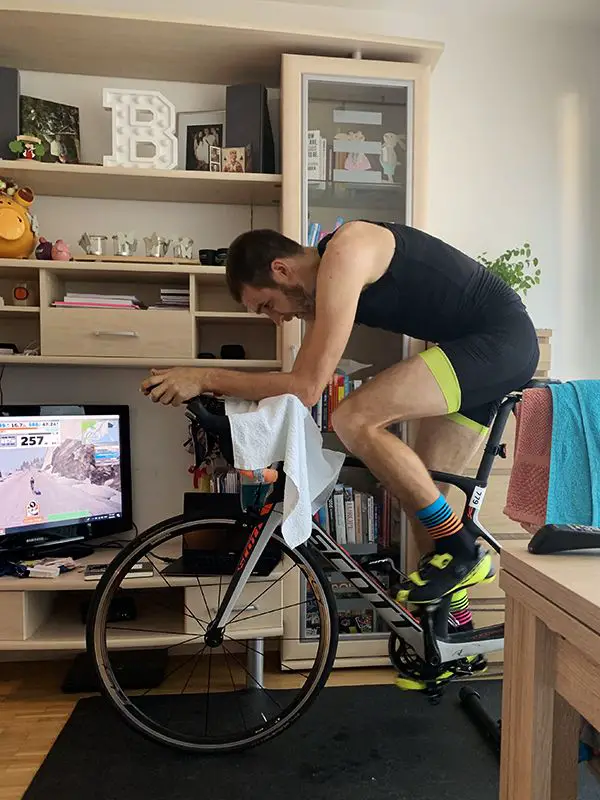
Indoor training
To get as productive as possible I moved almost all of my Ironman bike training indoors (except for some easy sessions to enjoy the process). That saved me lots of time on logistics & preparation, like getting dressed or considering which route to take. Often it would take me 20-30 minutes just to get ready, whereas on a trainer I’d be halfway through my session.
With indoor training there’s no time wasted – you just get on a trainer and go. There’s no traffic, no stop lights, no bad roads, no excuse for bad weather. Also, as the trainer controls the resistance you can create and execute a high quality session focused on specific training need.
For my Ironman bike training I used Zwift game app where I set up various training sessions with specific intervals. To be as productive as possible, for most of the sessions I had an audio book, an informative podcast or some documentary playing in the background.
Since I did 70% of volume on the bike, this almost automated my already minimalist Ironman training.
Training in time, not distance
Counting minutes and hours is a much more productive way to manage time than counting kilometers. A two-hour-long bike ride is what it is – two hours long. After all, every day is different and completing a specific distance can take more time. Time on your feet or in the saddle is everything that matters. Not how many kilometers you’ve covered.
Training in time provides more certainty on how long the training will take and makes you less attached to the outcome (i.e. how fast you’ve run the distance). This is especially important during the slow process of building aerobic base.
It’s also easy to schedule this kind of training as well. I often managed to squeeze in a 30-minute run during lunch or an hour-long bike session when I had extra time.
My minimalist Ironman training program periodization
I started my minimalist Ironman training program in mid-December for IRONMAN Austria in early July. That’s exactly 30 weeks which I’ve split into 4 key phases:
- Aerobic base
- Power build
- Distance & peak
- Taper
Until the peak phase I averaged 9-11 hours across swimming, biking, running and strength training. Since my training was split into many shorter sessions I didn’t take traditional approach of taking a recovery week after 3 intense ones. Instead, I took it easy once I felt fatigue accumulating or was traveling.
Related: How To Measure Post Workout Recovery And Avoid Accumulated Fatigue
Phase 1 – building aerobic base
To me the biggest challenge throughout the whole Ironman training program was to mentally accept the distance. I’ve never swam 3.8K and never ridden more than 100K in a single session. While I did run a couple of marathons, none of them were done after already exercising for 6+ hours.
So, phase 1 was all about building confidence on the bike. That included lots of long rides at easy intensity, just focusing on the overall distance and time in the saddle.
The timing of this phase was very good. During Christmas holidays and January weekends I managed to do a series of ‘mini camps’ – 2-3 days long with two ~2 hour aerobic sessions each. It really helped to build up the aerobic base
During this phase I also worked on swim technique in the pool, but didn’t do any running.
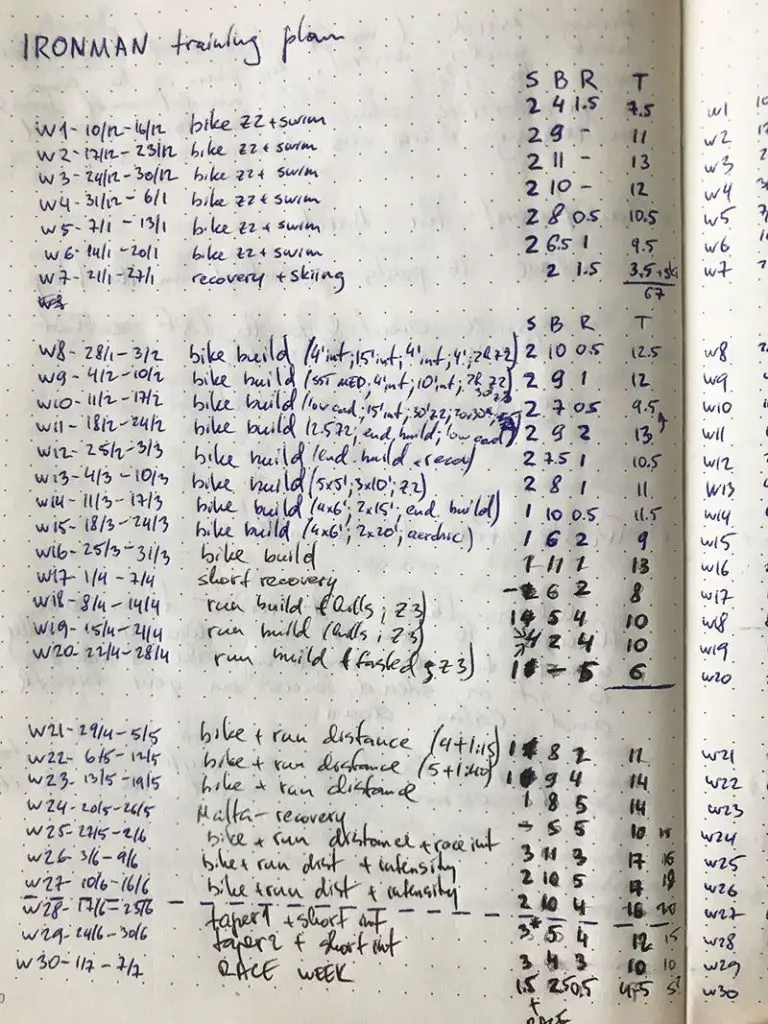
Phase 2 – building power
Once it got warmer I started adding easy brick runs after the bike (10-15min max and no higher than Zone 2).
What I quickly noticed was that my easy pace dropped from around 5:20min/km when I trained for Berlin marathon last year to around 4:50min/km. That’s purely from the bike base I focused on in Phase 1.
Towards the end of the phase I added some hill repeats and Z3 intervals to build some run-specific strength.
Bike was still my priority. Throughout the first half of the phase I did a solid block focusing on building power. During the week I did a mix of long Z3 intervals (20-30min), short threshold intervals and low cadence work. On the weekends I was building the volume towards a 4-hour-long easy ride.
Phase 3 – adding distance & peaking
As I got closer to the race, weekends gradually grew longer. To mix it up and avoid going too long I combined cycling and running. Generally, I planned a long bike with a run afterwards on Saturday and a short bike with a long run the next day to simulate running on tired legs.
So, instead of ‘traditional’ 5-6 hour bike ride on Saturday and 3 hour run on Sunday my weekend looked like this:
- Saturday – 4-5 hour ride with some Zone 2-3 intervals. Up to 1 hour long run right after the bike
- Sunday – 1 hour long easy bike with a 1.5 to 2 hour long run right after the bike
Saturday’s 4-5 hour ride with some intervals got me to around 180-220 TSS (Training Stress Score). That’s roughly the same stress as experienced during a race. It was definitely good to get an idea of how I’d feel at the start of the Ironman marathon.
I also did some fully fasted 2-3 hour bike rides to stimulate the use of fat sources in the body and semi-fasted low intensity long days.
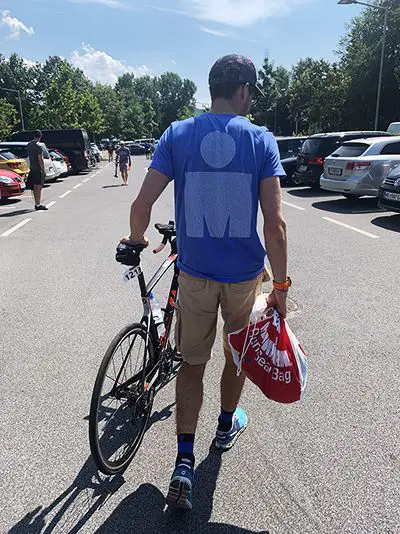
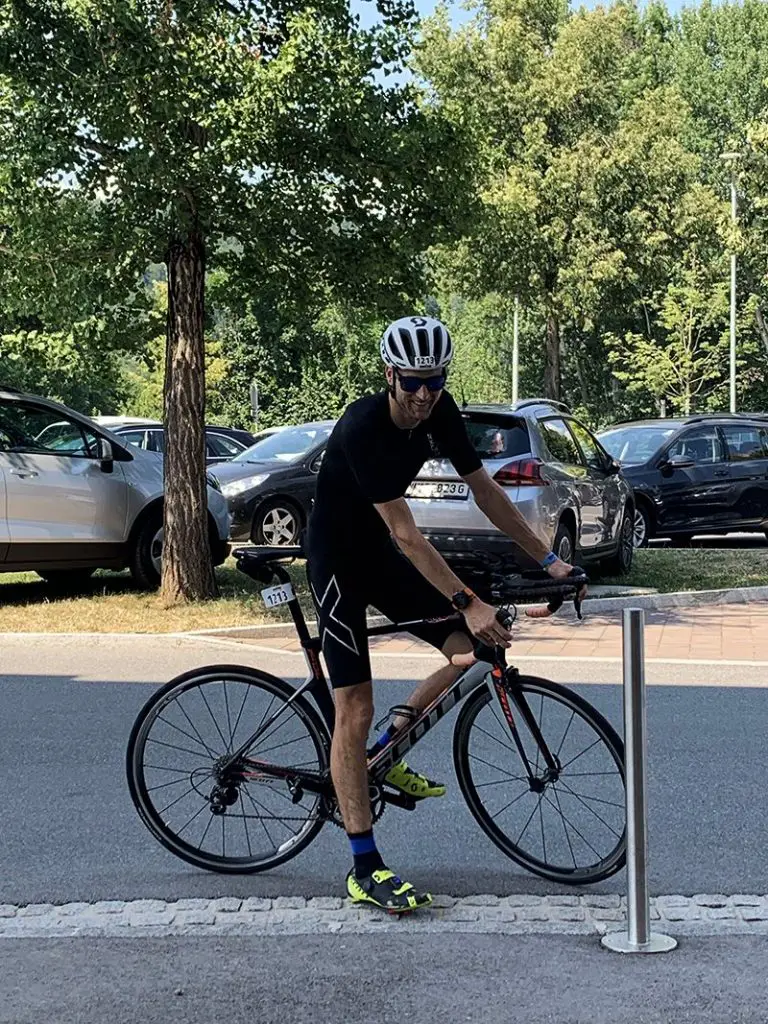
Where I think I went a bit overboard was in the last couple of weeks of the peak phase. I added both distance and intensity, which is something you should never do.
I rarely cut a session short. However, there was one I remember well – 4x3min in high Z4 – that I didn’t finish.
Related: Analyzing My First Ironman Triathlon – What Would I Do Differently?
Overall, I think that mistake had an impact on my race. I struggled to recover during the taper weeks and my legs felt quite tired despite frequent foam-rolling and self-massage.
Phase 4 – tapering
The structure of this phase was similar to my marathon taper. However, I added a week, because the overall load in the past months was very large.
- Week 1: 12 hours (down by 25%). Intervals in Z2/Z3 (duration also down by 25%)
- Week 2: 8 hours (down by 1/3). Intervals in Z2/Z3 (duration also down by 1/3)
- Week 3 (race week): 4 hours (down by 50%). 2-5 minute intervals at race pace and short (up to 20sec) bursts at 80-90% effort.
Besides cutting down the bike and run volume I added 1-2 extra swims per week. Those were open water swims done at ~6-7AM in the lake nearby to simulate the early race start. Each session was ~30 minutes and helped to maintain core strength and get accustomed to swimming in the wetsuit. Which I didn’t need after all...
Given my over-reaching during peak phase, I think my minimalist Ironman training program worked well. I tapered well and intervals in Z2 & Z3 helped to bring back most of the power and endurance I’ve built over the past months.
Did you find this information useful? Share the post with others using the buttons below.
Have an opinion? Share via links below and tag @theathleteblog
Tags In
Andrejs Birjukovs
GET A FREE TRAINING PLAN
Subscribe to my email list and get access to a free 4-week “back in shape” training plan
You’ll also get two full-body strength sessions and some other goodies!
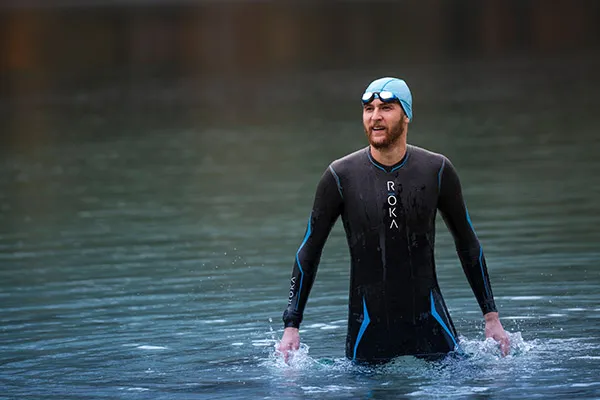
How did I get here?
Hey there! My name is Andrejs and I am here to inspire, entertain and get you fit for any adventure.
I went from being an over trained pro athlete to an endurance coach sharing how to listen to your body and live life to the fullest.
Traveling, new sports & activities brought new meaning to my training and made it much more effective, fun and enjoyable. And I'm here to help you do the same.
